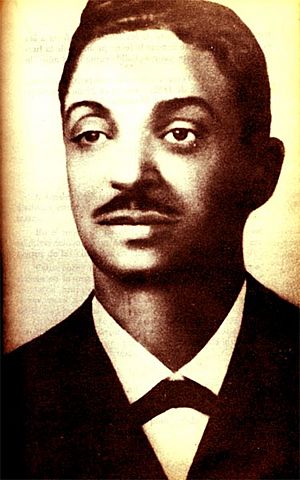Miguel Faílde facts for kids
Miguel Faílde Pérez (born December 23, 1852, in Guacamaro, Matanzas – died December 26, 1921) was a famous Cuban musician and bandleader. He is known as the official creator of the danzón, a popular Cuban dance and music style. He also wrote the very first danzón song, called Las alturas de Simpson. Miguel Faílde also started his own music group, the Orquesta Faílde.
Contents
Early Life and Music
Miguel Faílde's father came from Galicia in Spain. His mother was a parda, which meant she had mixed heritage. Miguel learned music from his father, who played the trombone. When he was just ten years old, Miguel played the cornet in the firemen's band in Matanzas.
Later, he studied harmony and composition with a French teacher named Federico Peclier. He also learned to play the viola and the double bass. Miguel Faílde was one of many musicians who secretly worked against the Spanish rulers of Cuba. His life happened during the time of the Cuban War of Independence.
Creating the Danzón Dance
Miguel Faílde's orchestra was very successful. But his biggest achievements were creating the danzón and writing many songs. Many of his songs have been changed to fit other music styles since then.
Faílde said that the danzón grew from an older dance called the danza. And the danza itself came from the contradanza. He once said, "From the danza to the danzón was a simple step." However, it was not quite that simple.
How the Danzón Was Different
The danzón was a much slower dance than both the contradanza and the danza. It also allowed dancers to pause between different parts of a song. Both of these features were very welcome in the warm climate of Cuba.
Perhaps even more importantly, the danzón was a dance for couples. But it was not a moving dance like the waltz, where couples travel around the floor. The contradanza and danza were both "sequence dances." This meant they involved everyone on the dance floor, like most ballroom dances before the waltz.
Danzón vs. Habanera
Before the danzón became popular, the habanera was the favorite dance. It was also a slow dance and came from the contradanza. The habanera was often sung, which the danzón was not until much later.
Both the danzón and habanera used special Cuban rhythms. In the danzón, this rhythm is called the cinquillo. It can be hard to know why one music style becomes more popular than another. The quality of the songs and the bands that play them likely played a big part.
Who Really Invented the Danzón?
Some people wonder if Miguel Faílde truly invented the danzón. This doubt comes from the work of Manuel Saumell. Saumell created many rhythms that became popular later in the 1800s. He might be the most important Cuban composer of that century.
In the end, the Cuban government officially named Faílde the inventor of the danzón. This happened in 1960. By that time, the danzón was not as popular. Its "child" dance, the chachachá, had taken over.
Later Life
Miguel Faílde passed away in 1921. He was buried in the Necropolis San Carlos Borromeo in Matanzas.
See also
 In Spanish: Miguel Faílde para niños
In Spanish: Miguel Faílde para niños


